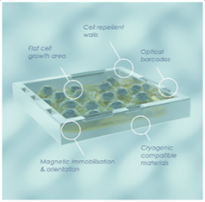
- Applications
-
Products
-
Liquid Handling
- firefly Accelerate genomic research with innovative all-in-one, compact liquid handling
- mosquito Nanolitre liquid handling technology performs ‘traditional’ tasks at a fraction of the volume, and higher speeds
- dragonfly Delivers accurate and repeatable nanolitre to milliliter dispensing
- apricot Automated liquid handling instrumentation for convenient general use across your entire team
- Sample Preparation
-
Sample Management
- comPOUND A scalable, reliable, and secure compound management solution
- BioMicroLab Easy-to-use sample management automation instruments
- arktic Robust biospecimen storage and management down to -80°C
- lab2lab Novel sample and data transfer network system
- comPACT Reliable and efficient -20°C storage and retrieval has never been more accessible
-
Liquid Handling
-
About
- Company With a focus on liquid handling, sample preparation and sample management, our expert teams create state-of-the-art solutions that scientists and researchers can trust Culture We have one overarching mission: to work together to accelerate life science research. Through our innovative solutions and state-of-the-art tools, we believe we can make a real difference to human health Partners Collaboration is key in our mission to make a real difference to human health. Partnering with application leaders globally, we co-create to solve new challenges across the life sciences. Innovation From the initial prototype through to manufacturing, installation and beyond, we bring a problem-solving mindset and technical expertise to drive innovation
-
Executive Leadership
 Through strategic guidance, visionary thinking, and a relentless pursuit of excellence, our senior executives steer SPT Labtech towards achieving its mission of making a real difference to human health through solving advanced laboratory challenges.
Learn more
Through strategic guidance, visionary thinking, and a relentless pursuit of excellence, our senior executives steer SPT Labtech towards achieving its mission of making a real difference to human health through solving advanced laboratory challenges.
Learn more 
-
View all
 Board of Directors
Board of Directors
 Our Board of Directors are committed to driving the long-term success and sustainability of SPT Labtech, providing expert guidance and oversight to execute the company’s ambitious commercial strategy.
Learn more
Our Board of Directors are committed to driving the long-term success and sustainability of SPT Labtech, providing expert guidance and oversight to execute the company’s ambitious commercial strategy.
Learn more 
-
Knowledge Base
- Resources Our wide range of insightful resources include videos, whitepapers, eBooks, application notes and more Events & Webinars Meet the SPT team at events all over the globe and virtually via our webinars Podcast We chat with innovators and leaders from across the community to gain their unique insights. News Latest news from SPT Labtech globally Blog Our latest blog posts feature trends in research, innovative techniques and new technology
-
22 September, 2025
 How Novartis Is Shaping the Future of Lab Automation Through Smart Sample Transport
Continue reading
How Novartis Is Shaping the Future of Lab Automation Through Smart Sample Transport
Continue reading 
-
09 July, 2025
 SPT Labtech and Semarion Collaborate to Advance Automated Cell-Based Assay Workflows
Continue reading
SPT Labtech and Semarion Collaborate to Advance Automated Cell-Based Assay Workflows
Continue reading 
-
23 June, 2025
 SPT Labtech Named Illumina Qualified Methods Provider Following Successful Automation of Illumina DNA Prep on firefly® Platform
Continue reading
SPT Labtech Named Illumina Qualified Methods Provider Following Successful Automation of Illumina DNA Prep on firefly® Platform
Continue reading 
10
- Careers
- Home
- Field Application Scientist
- Ivan Fong
Ivan Fong
Field Application Scientist
Individual responsibilities
I build strong working relationships with customers and advise them on how to best use SPT Labtech products to achieve their scientific goals. I am primarily responsible for our chameleon instrument. This instrument encompasses the latest technologies in cryo-EM grid preparation, which have the potential to tackle preferential orientation problems and air water interface denaturation issues when making cryo-EM grids. This instrument will make it easier for scientists to overcome the technical hurdles in cryo-EM to find answers to their scientific questions.
I also gather user feedback to help our Research and Development Team improve instrument design and reduce bottlenecks. Additionally, I test run new instrument designs under development, as well as stay up-to-date on the latest research trends to help guide future product development.
Skills
Scientific knowledge is a given in my job role. However, there are also a number of core competencies that are critical to success. An absolute must-have is good communication skills. Active listening, observing, empathizing and talking with customers are all essential to providing an exceptional experience centred and trust and transparency.
Responsibilities
I am part of a team of Field Applications Scientists (FAS).
Our department of FASs play a fundamental role in ensuring customers get the most out of their instrument outputs and workflows. We first and foremost provide scientific advice and assist laboratory teams in the installation of instruments and design of scientific applications.
The team are PhD-level scientists, specializing in certain areas ranging from genomics to structural biology. The breadth of a FAS team’s training and expertise is a fantastic benefit to our customers as their support gives them confidence to pursue innovative ideas.
We are involved in the very early interactions of the purchasing process, through to product demonstration, installation and ongoing usage and optimization of SPT instruments.
Best parts of the job
I enjoy the variety the job role brings. I have all kinds of daily tasks ranging from technical to communicative. I am always searching for opportunities to expand my knowledge through meeting new scientists and love to work collaboratively with customers.
Professional Achievements
I was part of a team that determined a very large and complex protein structure called the MS-ring in bacterial flagella. I developed the protein expression and purification procedures and also optimized the cryo-EM grid preparation. The protein complex was quite fragile and could only be obtained in small quantities. It also had preferential orientation on cryo-EM grids, a common problem encountered in cryo-EM grid preparation. We found that crosslinking the protein complex helped to mitigate preferential orientation, in addition to improving sample stability. We additionally used cryo-EM grids coated with a graphene oxide layer to concentrate the sample on the grid to overcome the limited availability of protein samples. We eventually published this paper in Nature Microbiology.
Professional Ambitions
I would like to continue to help scientists overcome roadblocks in their research work and drive efficiency in their labs so they can focus on making ground breaking discoveries.
More about Me
I became fascinated by the idea of understanding life at the atomic scale as an undergraduate student. Moreover, research tools used in structural biology research tend to be much more exotic and expensive which, again, is one of the main reasons why it fascinates me. I went on to complete a PhD at the Chinese University of Hong Kong and then completed a post doctorate at the University of Oxford before taking my position as an Application Scientist at SPT Labtech.
Outside of work, I enjoy street/portrait photography. Structural biology encompasses capturing pictures of protein molecules to understand how they function at a molecular scale. I see photography as an extension of what I do professionally, as a scientist. I am still taking pictures now, but of places and people, not proteins!

